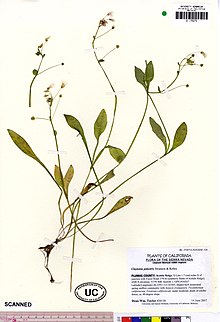| Claytonia palustris | |
|---|---|

| |
|
Scientific classification
| |
| Kingdom: | Plantae |
| Clade: | Tracheophytes |
| Clade: | Angiosperms |
| Clade: | Eudicots |
| Order: | Caryophyllales |
| Family: | Montiaceae |
| Genus: | Claytonia |
| Species: | C. palustris
|
| Binomial name | |
| Claytonia palustris Swanson & Kelley
| |
Claytonia palustris is a species of wildflower in the family Montiaceae known by the common names Jonesville springbeauty and marsh claytonia. Often mistaken for Claytonia sibirica, the species is diploid (2n = 12) with a chromosome base number of x = 6. [1]
Distribution
The wildflower is endemic to California where it is a rare species indigenous to wetlands including bogs, fens, meadows and streamside riparian thickets at low- to mid-elevations of the Klamath Mountains, Cascade Range, and Sierra Nevada as far south as the Kern and Tule River watersheds. [2] The species epithet palustris is Latin for "of the marsh" and indicates its common habitat. [3]
Description
Claytonia palustris is a rhizomatous perennial herb producing a slender stem up to about 0.5 metres (1.6 ft) long. It has leaves with oval-shaped blades a few centimeters long at the ends of long, narrow petioles. The inflorescence bears up to 18 flowers on a long stalk. Each flower has 5 white or pink-tinted white petals just under a centimeter long. The bloom period is May to October.
References
- ^ Miller, J. M. and K. L. Chambers. 2006. Systematics of Claytonia (Portulacaceae). Systematic Botany Monographs 78: 1-236. ISBN 0-912861-78-9
- ^ Miller, J. M. and K. L. Chambers. 2006. Systematics of Claytonia (Portulacaceae). Systematic Botany Monographs 78: 1-236. ISBN 0-912861-78-9
- ^ Archibald William Smith A Gardener's Handbook of Plant Names: Their Meanings and Origins, p. 258, at Google Books
External links
- Calflora Database: Claytonia palustris (Jonesville springbeauty, Marsh claytonia)
- Jepson Manual Treatment
- Flora North America
- Photo gallery